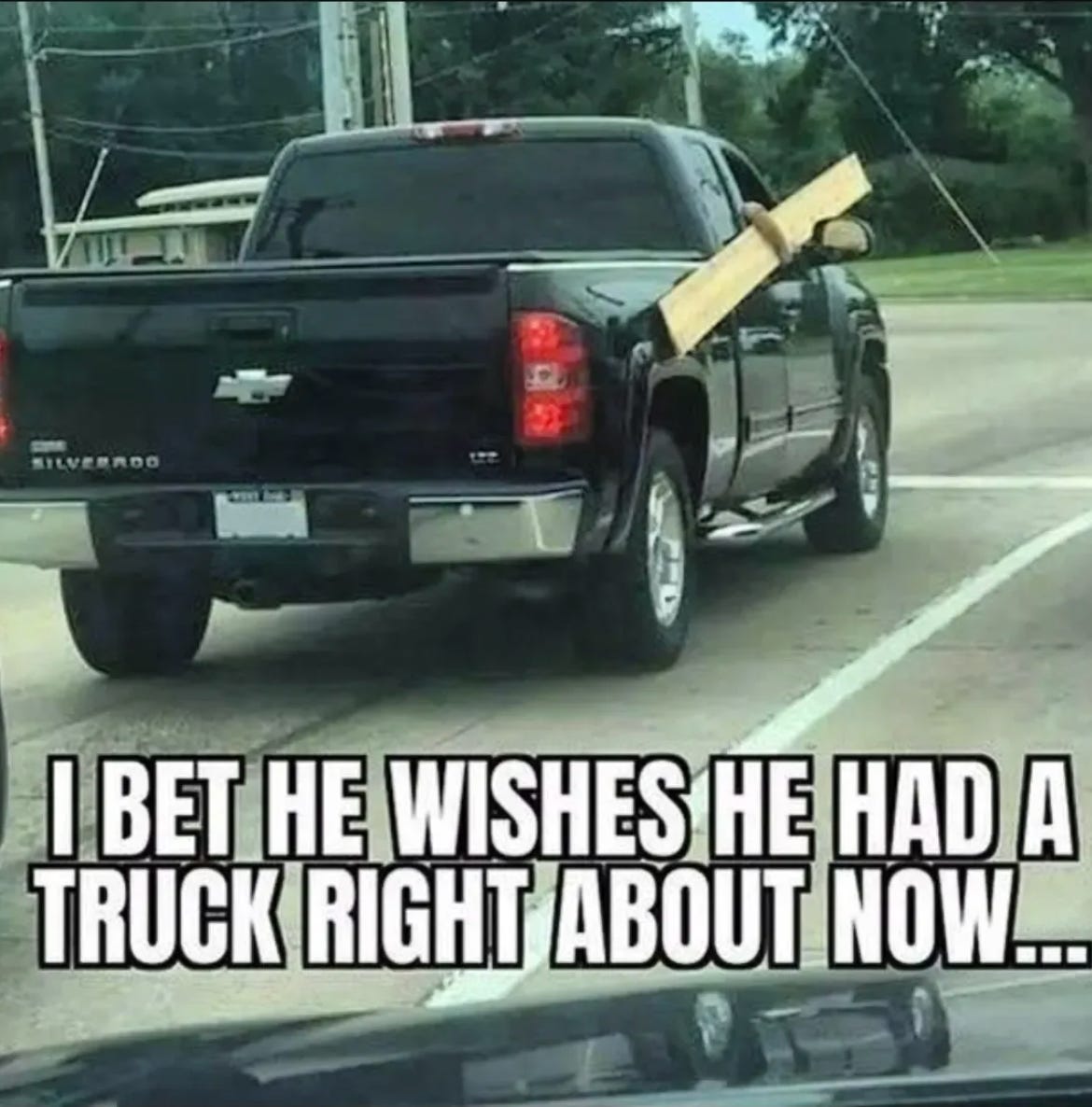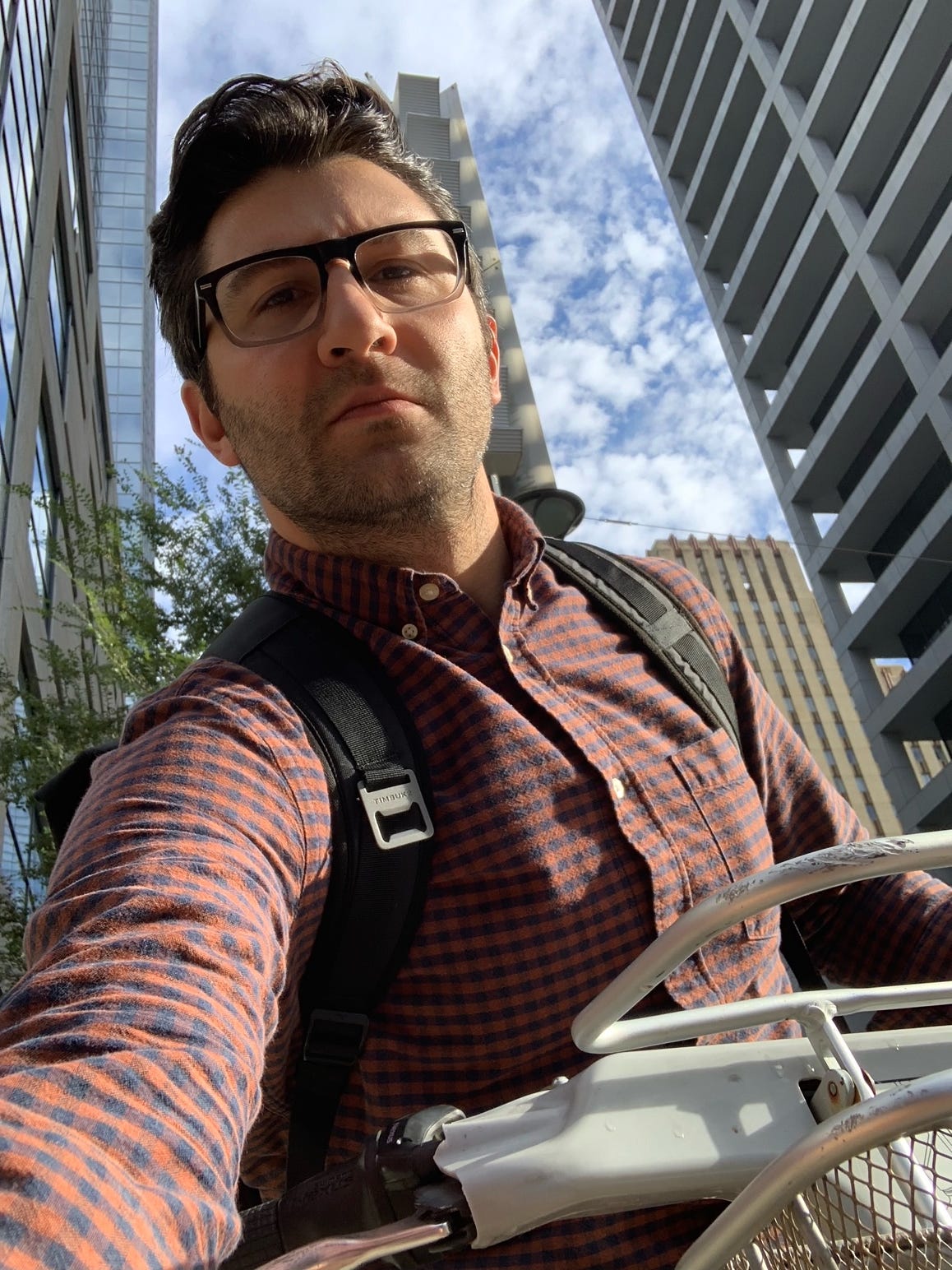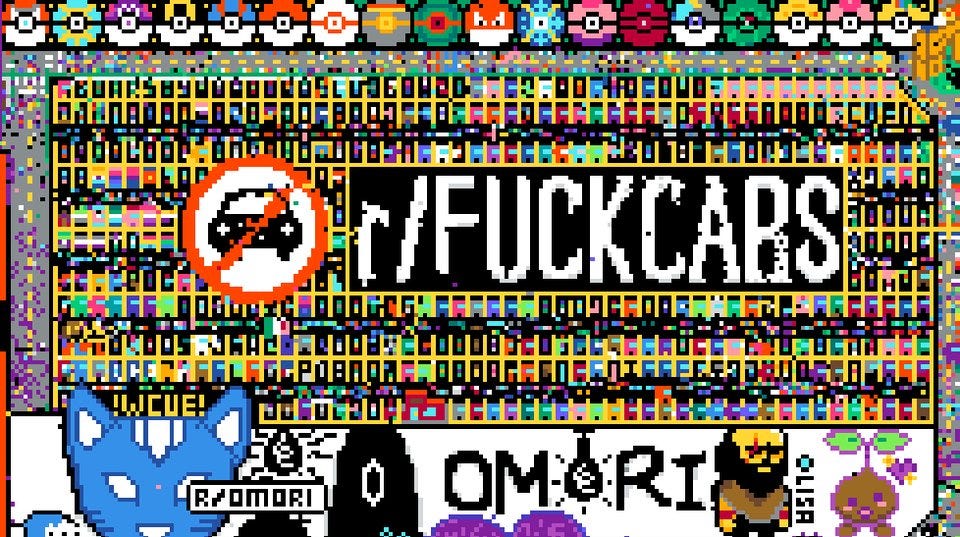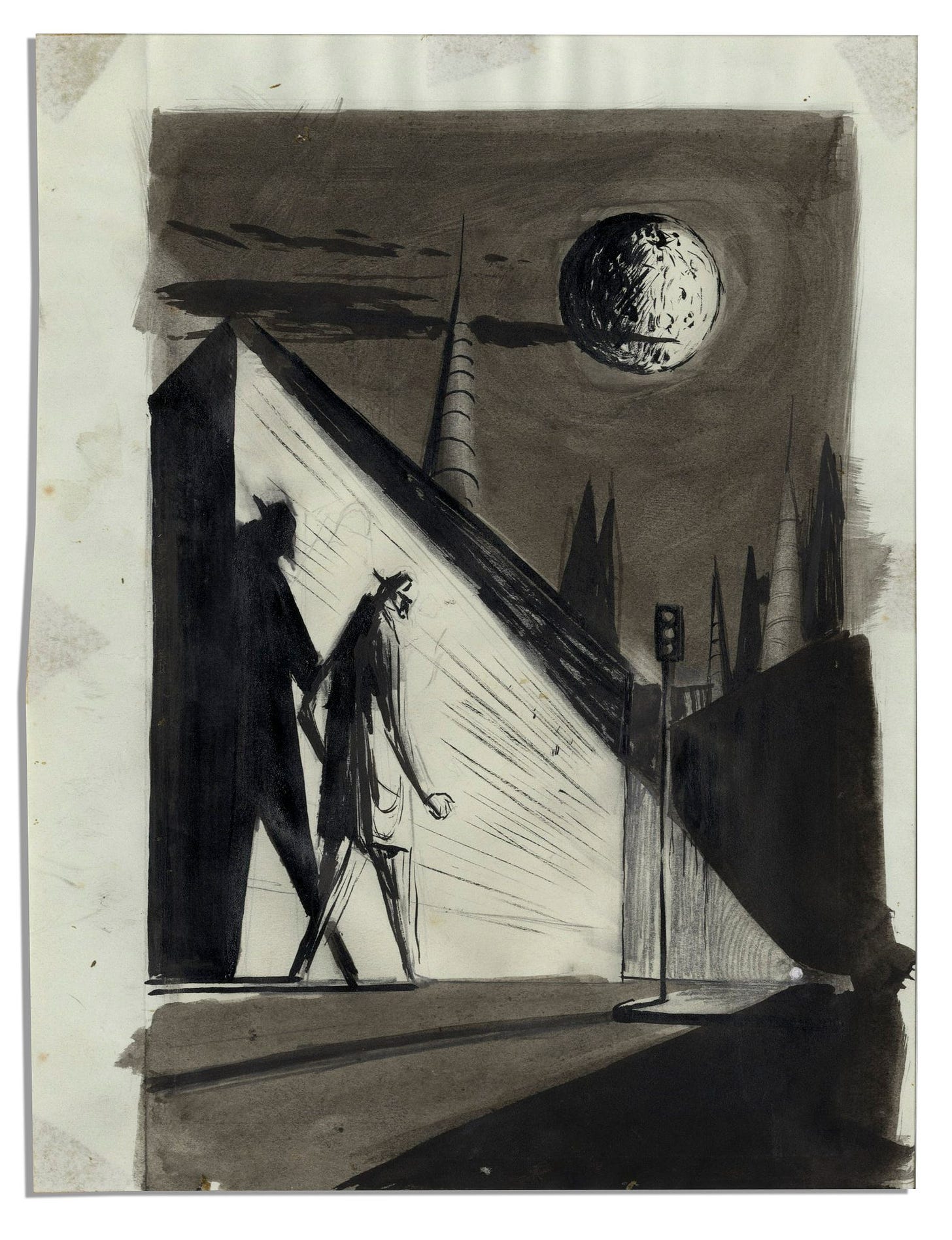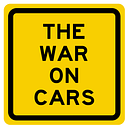

Discover more from The Traffic Report
We hope you enjoy this edition of The Traffic Report. This newsletter is free, but if you want to support The War on Cars and help us produce the podcast, become a Patreon subscriber today.
It’s no secret that the typical American pickup truck has grown absurdly large, becoming to transportation what a peacock’s tail is to evolution: Something so completely removed from its original practical purpose that today it serves mainly as a social signifier to other members of the species. Unfortunately, those other members of the species are, well, pedestrians, cyclists and every other human sharing the roads with massive pickups — and what message the drivers of such impractical and unnecessary trucks are sending is something for Freudian analysts to understand and academics to study
Impractical? Unnecessary? Anytime one points out that today’s growing number of giant SUVs and pickups are rarely used for the things such trucks are ostensibly good at, every person who responds claims to be a contractor or someone who, for some reason, is constantly towing trailers loaded with refrigerators to remote locations in the woods. But as Brett Berk put it in The Drive in 2019, while owners of large pickups “are slightly less likely than owners of other categories to use their vehicle as primary transport (83% vs. 95%),” most drivers don’t use their trucks for the things the auto industry depicts such vehicles doing in commercials, such as as pulling trailers or scaling mountains:
…75 percent of truck owners use their truck for towing one time a year or less (meaning, never). Nearly 70 percent of truck owners go off-road one time a year or less. And a full 35 percent of truck owners use their truck for hauling—putting something in the bed, its ostensible raison d’être—once a year or less.
Anyone who understands how ridiculous it is to pilot a 6,000-pound lifted pickup to haul not lumber but Little League equipment will get a kick out of an Instagram account called @BigDumbTruckClub. The account features pictures of giant pickups in their more natural habitat, such as parked in fast food restaurant parking lots or on regular American highways, each image typically accompanied by biting commentary or meme-style text cutting these trucks — and their owners — down to size.
We spoke to the account’s creator, who gave his first name only, but who had lots of opinions about what he calls “the single most inefficient mode of American transportation.”
This interview has been edited for length and clarity.
Tell us a little bit about yourself.
My name is Joe and I'm based in the Pacific Northwest. I'm a cyclist of all kinds—road, gravel, commuter, etc.—but my racing days are long gone. I focus my time now advocating for rail trails in Washington State, getting people interested in exploring them, as well as advocating for better bike infrastructure in town for commuters. I'm a bike mechanic by trade, so I'm completely enveloped by bicycles.
What was your motivation for creating @BigDumbTruckClub account?
The account is kind of the pinnacle of my anger and frustration with the lack of awareness of most folks regarding just how big cars have gotten, and the destruction they can cause. I've always dealt with cars as a cyclist (like that’s just the way it was if you wanted to ride bikes), but years ago, when my kids were young and just starting school, I started getting frustrated at how difficult it was to walk them to school and cross through the line of SUVs and trucks that seemed to keep getting bigger. I thought I was crazy, but one day in a parking lot I saw an older F-250 parked next to a newer one and it was just like, there it is. They newer one was absolutely huge in comparison. From then on, it was just a running joke with my wife and I, whenever we'd see a guy using a massive pickup truck to do normal things like grocery shop or pick up kids from school, she'd point and say, "Big dumb truck club."
Trucks sometimes have to be even bigger than what you document on your account to catch people’s attention. What caused you to notice how absurdly large pickups were becoming?
In 2019 we visited Ghent and the Netherlands. I'm sure you know the logical conclusion of having to come back home. The size of trucks in America felt absolutely offensive. I would talk to people and point out the size of vehicles and they would just be like, "that's just how cars are.” I realized that it had happened so slowly that most folks didn't even realize it, and we don't really focus on pedestrian/cyclist/traffic deaths in the news. It's just part of our cognitive dissonance in a car culture. I also realized that if you've never been passed on a bike by a 6,000-pound truck with a foot of space between you and coal rolled, or had a friend killed by a truck, you may not grasp the severity of the situation.
Why did you think an Instagram account infused with humor would be an effective way to call attention to this issue?
I like to read, and I like podcasts, but I was finding it difficult to talk to people about these issues who aren't already aware of it. I figured if I made a meme page to make people laugh, maybe I could also sprinkle in some statistics and help move them along a little bit. Like, "Look, here's a stupid truck and it's funny, but also here's some real facts about traffic fatalities and poor street design!" I didn't think that just coming outright with violent rhetoric and "fuck cars" would be useful as there are already pages that do that and they're just preaching to the choir. I was more interested in seeing if I could grab the attention of folks who may have never realized just how dumb it is that their neighbor drives a lifted super duty as a daily driver and he only tows something twice a year in the summer.
🤠 Houston, We Have a Traffic Problem
We now take you from Joe on Instagram to Joe in Houston. Joe Cutrufo is the Executive Director of Bike Houston. Cutrufo, who formerly lived car-free with his wife and two children in Manhattan, purchased a car shortly after moving to Texas. But instead of getting a randomly assigned license plate, he selected a vanity plate that fits his status as a both an enthusiastic new resident of Houston and a reluctant car owner: BAN CARS.
This interview was conducted via e-mail.
What inspired you to go for it and get a BAN CARS vanity plate?
I saw a tweet with a New York plate that said BAN CARS and I knew immediately that was the plate I needed.
Were you nervous the text wouldn't be approved by the Texas DMV?
Absolutely. The only thing that might be more difficult to get approved might be BAN GUNS.
What has the reaction been from other drivers? We can imagine people trying to Mr. Gotcha you and say, "You want to ban cars and yet you drive one. Very curious!"
Surprisingly, I haven’t had any negative reactions, at least not to my face. I did have one interaction with someone in a parking lot who was loading stuff into the car next to mine. He pointed at my plate, smiled and said, “That’s my kind of person.” Oh and one of my neighbors saw it and said “that’s like putting a sign in front of your house that says “BAN HOUSES.”
You used to live car-free in New York, where you worked as the Communications Director for Transportation Alternatives. How has the transition to a more car-dominated place gone for your family?
Houston is a different city in a lot of ways, but we actually bike more here than we did in New York. My wife and I take our kids to school on a cargo bike, and they even ride their own bikes on the street, at least within our neighborhood, which I don’t think they could’ve done in Manhattan. My office is a ten-minute bike ride from home, and we live as close to the light rail here as we lived to the A Train when we were in New York. Car culture imposes itself on you in a different way. Instead of people parking in crosswalks and bike lanes, it’s just parking lots everywhere, even in the denser, more urban parts of town.
As Executive Director of BikeHouston, how do you approach the idea of challenging car culture and changing people's perceptions of cycling in a city known for sprawl, big trucks and Big Oil?
The energy industry of course has a major presence here, but it’s not as all-consuming as I had imagined, at least not for me. Like you don’t have to think about Wall Street when you live in New York if your friends and family don’t work in finance. And so many Houstonians come from another part of the country, or another country altogether — it’s the most diverse city in America after all — so it’s not like I’m constantly going toe to toe with someone in cowboy boots telling them to ditch their F-150 and get on a bike. There’s a saying here, that Houston isn’t a city, it’s a condition. So most of the people I encounter are pretty open to the idea of change, because that’s what Houstonians are used to. And anyone who comes to this city with good intentions and a willingness to roll up their sleeves is welcomed with open arms. Even a bike advocate from the northeast (who constantly complains about the relative lack of good pizza down here).
In New York, you organized the 5 Boro Pizza Challenge, a race to travel car-free to all five boroughs and eat a slice of pizza at some of the city's best pizza joints. In Houston, you've organized the World Taco Day Ride. The Pizza Challenge was competitive, but the Taco Day Ride is social. Why the different approach?
I have a dream of one day turning this taco ride into something more like the 5 Boro Pizza Challenge. It’s mostly timing and staffing, and the fact that I’m not exactly a taco connoisseur — yet. But the tacos here are amazing.
As far as becoming a bike-friendly city, what advantages do you think Houston has? What excites you about the potential for change where you are now?
Houston is a few years behind some other cities when it comes to multimodal transportation, but we have the advantage of watching what other cities have struggled with and sort of leapfrogging the trial-and-error period. Like all our new protected bike lanes are getting these big heavy concrete curbs, or they’re being built cycle track style, up a level from the street. We don’t do is “protect” bike lanes with flex posts.
But beyond the bike lanes, there’s just the space in general. There’s pushback sometimes, but we’ve got lots of excess capacity and redundancy in our street grids. New York will always be a more walkable city, but Houston, at least inside the (I-610) loop could actually become a more bikeable city, if we ramp up investments in really good quality bike infrastructure, and frankly, if we can do more to address chronic speeding and red-light running. Or in other words, if we ban cars.
🎙 Our latest episodes
Episode 84: They Paved r/place and Put Up a Parking Lot
From the joy of the “Just a Minute” campaign in San Francisco to the members of a colorfully named subreddit creating a digital parking lot, there’s a lot of news in The War on Cars. We hear from listeners around the country and across the Atlantic. Is it possible to be more chill about people riding the wrong way in a bike lane? Should public transit be free? Why is it so hard to find a good bicycle with all the accessories you need for regular transportation? Plus, quick dispatches from the hosts’ trips to car-dependent parts of the United States.
Episode 83: The Pedestrian
Back in 1952, the great American science fiction writer Ray Bradbury published a short story called “The Pedestrian” in a small antifascist publication. The story, which was based on Bradbury’s own experience of being hassled by the cops while walking the streets of Los Angeles, imagined a world in which automobile dominance was so complete that walking for any purpose would be seen as a sign of mental illness. We take a look back at Bradbury’s dystopian vision, and talk with four people — paleoanthropologist Jeremy DeSilva and writers Garnette Cadogan, David Ulin and Antonia Malchik — about how walking contributes to our essential humanity, and what we lose when we build environments that make it impossible for people to walk.
The War on Cars is available wherever you get your podcasts. And, hey, if you like what you hear why don’t you leave a rating and review for us at Apple Podcasts? It really does help people find us!
🚶🏽♀️🚶🏽👩🏻🦽 Build The Walkable City with Jeff Speck
SPONSORED POST: What makes a place walkable? What do design professionals, engineers, developers and public officials need to know if they are to make streets and communities more attractive to people who aren’t in cars?
Join Jeff Speck — author of the best-selling book, "Walkable City" — for a two-day course at the Harvard University Graduate School of Design Executive Education on the most effective arguments, tools, and techniques for improving walking, biking, and transit. You’ll learn powerful strategies for building stronger, healthier, more equitable places by focusing on walkability. And you’ll get hands-on experience working on a real-world planning project in the City of Somerville.
Whether you’re already an urban design professional, you aspire to become one, or you just want to learn more about how to make your own community more walkable, this course is meant for you.
The Walkable City course takes place June 13th and 14th, in-person, on the campus of Harvard University in Cambridge, Massachusetts. To learn more and to register, visit this link.
🌧 20% off Cleverhood rain gear
SPONSORED POST: Spring is here, and that means more walking and biking. Be ready for anything Mother Nature throws at you with rain gear from Cleverhood. Listeners of The War on Cars can receive 20% off anything in the Cleverhood store now through the end of April with code HAPPYCOMMUTE. Cleverhood donates 5% of their revenue to non-profit advocacy organizations working to make streets safer, sustainable, and equitable.
If you’ve read this far, treat yourself to 20% off all apparel orders in our official online store with code NEWSLETTER through May 1st.





